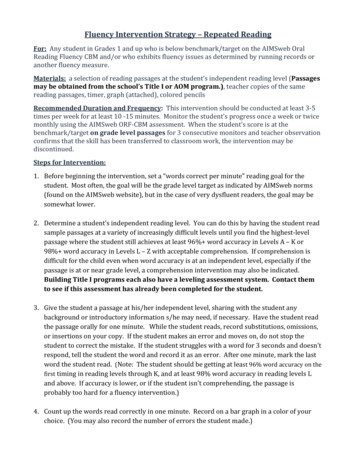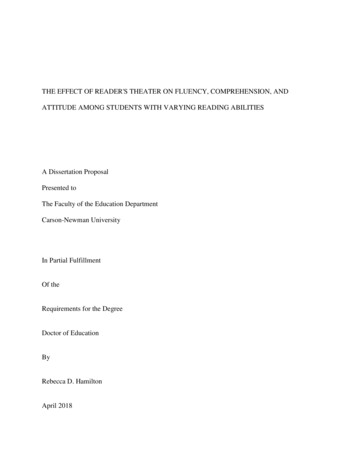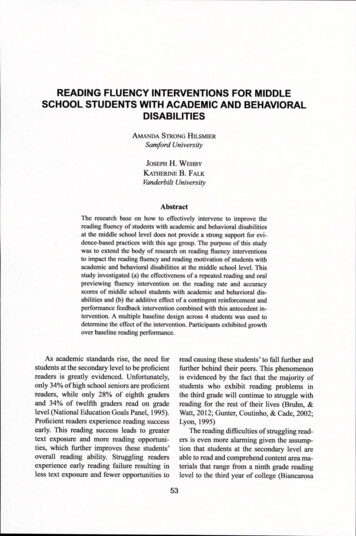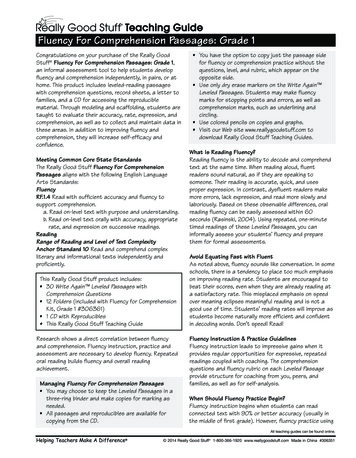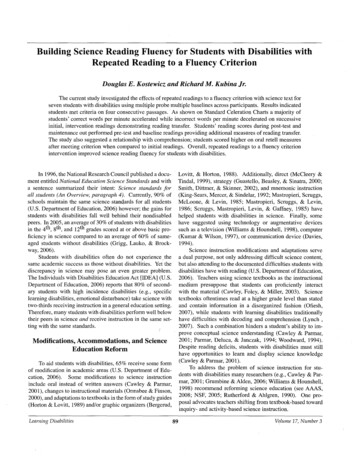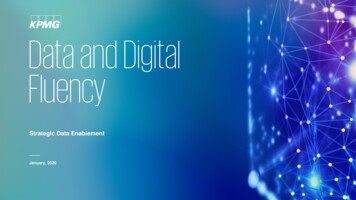
Transcription
Data and DigitalFluencyStrategic Data EnablementJanuary, 2020
Data is a fabric interwoven into the business andoperating models of organizations. It is a languagein an of itself.Changing customer expectations, evolvingregulatory requirements and fintech disruptionhas driven a clear business need to developfoundational data literacy into digital fluencywithin an organization. rved.reserved.2
Data and Digital Fluency – What is it? Data and Digital Fluency results when the necessary technical, operational and behavioral elements are integrated into an organization insuch a way that this ‘language’ becomes the new ‘business as usual’What it Looks LikeWhat Our People SayCommon understanding ofterms and languageNew levels of engagementand personalizationGetting results with less timeand effortEnriched, reliable and nonintuitive insightsGood people as well as goodactionsDialogue vs monologueWhat Our Leadership DoesMy skills are relevant tocreate valueI’m doing interesting andmeaningful workOur company is a leaderMy company supports mygrowthI have confidence in theintegrity of my work productsI am focusing on the rightthingsYou make it easy to dobusiness with youYou know me, mypreferences and anticipatemy needsI don’t need to tell my storyevery time I talk to youI would recommend you to afriendI get the right person when Ineed toYou offer me meaningfuloptionsWhat Our Customers SayMake intelligent insightbased decisionsSolve problems using datainsightsD&A is embedded in ouroperations and solutionsProtect the privacy of ourcustomers and employeesHighly responsive toregulatory demandsPartner effectively acrossbusiness units 2020 KPMG LLP, a Delaware limited liability partnership and the U.S. member firm of the KPMG network of independent member firms affiliated with KPMG International Cooperative (“KPMG International”), a Swiss entity. All rights reserved.3
Data and Digital Fluency – Why is it important?Nearly every organization is in some form of atransformative journey but benefits can be elusive 1.18T75%Projected spend fortransformation in 2019Of the projected spend will be ontechnology and connectivity56%84%CEOs planning toupskill their workforcein new digitalcapabilitiesFail to achieve benefitsbecause they are not preparedto change behaviorInsights & Analytics are the new normal but organizationsare struggling to keep pace77%Reported that businessadoption of Big Data/AIinitiatives is a majorchallenge, up from 65%last year96%69%86%53%Believe they have 2 years to makechanges before suffering financial orcompetitive consequencesState that they are notyet treating data as abusiness assetCompanies view digitaltransformation as criticalReported theyhave not createda data-drivenorganization93%72%Reported that people andprocess issues are theobstacle for achievingbenefits from their BigData and AI investmentsReported that they have yetto forge a data culture52%Admit that they arenot competing on dataand analyticsSources: KPMG’s 2019 Global CEO Outlook; IDC Worldwide Semiannual Digital Transformation Spending Guide, From Business Wire Harvard Business Review, February 2019 Despite significant investment, benefits have been dramatically affected by the lack of focus on building fluency and embedding thecapabilities into the company’s DNA 2020 KPMG LLP, a Delaware limited liability partnership and the U.S. member firm of the KPMG network of independent member firms affiliated with KPMG International Cooperative (“KPMG International”), a Swiss entity. All rights reserved.4
Client ChallengesOur clients are asking for help:With the data and digital agenda growing, clients have recognized a lack of proven methods, tools, and approaches to build a data- andinsights-driven organization, and have begun asking KPMG to help solve their current challenges.Significant competency gaps exists across business lines.Data and D&A accountability is limited to select SMEs within an enterprise function and there is a global shortage of datascientists. Organizations can’t rely on buying these skills; they must be built.Undefined data and insights-oriented personas or differentiated training.Training tends to be either too generic or highly specialized. Across any organization there are different levels ofengagement in the use and production of data, insights and/or AI. These relationships inform clear personas which in turnspecify learning paths, objectives, incentives and career progressions.Leadership lacks trust in the data and insights with cascading effects.A large majority of senior executives have a high level of mistrust in the way their organizations use data, analytics, or AI, sochoose to ‘go with their gut’ instead. Lack of trust is often a result of leadership not being properly educated on data, AI andanalytics, leading to cascading effects: lack of support for initiatives to drive organizational literacy and fluency, delays inadoption, stewardship fumbling and an inability to report, or meet expectations, on ROI.The traditional stewardship approach isn’t working.Resources have struggled to balance day jobs with data stewardship duties and often the business responsibilities areinappropriately assigned to Technology. A new approach and operating model that is grounded on business value andalignment of an organization’s strategic priorities garners better results and helps to build data and digital fluency.Source: KPMG 2019 Data Forum Report 2020 KPMG LLP, a Delaware limited liability partnership and the U.S. member firm of the KPMG network of independent member firms affiliated with KPMG International Cooperative (“KPMG International”), a Swiss entity. All rights reserved.5
Data and Digital Fluency – How Do We Approach It?Capabilities across four key domains provide an anchor to define foundational data literacy that can be built upon to embednew operational practices and achieve data and digital fluency.Data Governance / CoEData ProductionHow well the organization hasestablished an effective central functionwhose responsibility spans thetreatment of data as a strategic asset;and the extent to which its standardsand practices are embedded throughoutthe organizationHow well the organization develops dataand insights, including all necessaryfoundations, operations and supportData Consumption & UseTalent Management & theEmployee ExperienceHow well the organization utilizes dataand insights in performing individualroles and functions, and improving uponthe operating model and executivedecision makingHow well the organization recruits, hires,trains and rewards employees in respectto data, digital, AI and insight-drivenskills, capabilities and behaviors 2020 KPMG LLP, a Delaware limited liability partnership and the U.S. member firm of the KPMG network of independent member firms affiliated with KPMG International Cooperative (“KPMG International”), a Swiss entity. All rights reserved.6
Data and Digital Fluency CapabilitiesIn tandem with the four domains, these six capabilities define better and leading practice in respect to data and digitalfluency, and can be used to develop flexible solutions to help our clients with their strategic change agenda, regulatoryrequirements and tactical operational needs.CompetenciesTraining & LiteracyProgramsIncentives Data competencyinventory Independent andClassroom Learning Role-based PerformanceObjectives and Targets Talent Assessment Active Learning andImmersion Programs Accelerated TrackPrograms, certificationsand badging Role Definitions Progression Pathways Cultural and CommunityInitiativesCentralized Portals,Platforms, Apps, andTooling Achievement-basedmonetary rewardsEthics Data Code of Conduct Regulatory DataRequirements Privacy, Protection, andAccess Management Sharing & ConsentAgreements/FrameworksStewardship Data Ownership andOperating Model Alignment of StrategicPriorities to Ownership(ADSs, Data Processesand initiatives) Embedding LiteracyObjectives and Pathswithin the Business LinesCommunication Identification ofExecutive-level Sponsorsand Champions for Data Stakeholder EngagementModels & Approach Communications Strategy& Execution Plan 2020 KPMG LLP, a Delaware limited liability partnership and the U.S. member firm of the KPMG network of independent member firms affiliated with KPMG International Cooperative (“KPMG International”), a Swiss entity. All rights reserved.7
Achieving ValueWhether pursued as part of a program or standalone, we have identified a clear ROI that can result when an organization commits to thechanges needed to become data and digitally fluent.ROIDriversGreaterEmployee & ss improvements andredeployment of staff to highervalue added functions results in:The benefits of retainedInsights-driven analysis andRecognition of being a marketemployees and customers enables decision making increases revenue leader which increases the Netgrowth and differentiationthrough:Promoter Score due to:through: new levels of engagementand personalization appreciation that the increased penetration ofcompany supports employeeproducts and services togrowthexisting customers andattraction of new customers employees doing interestingEach of these a common understanding ofterms and languagedrivers can bequantified to ease of responsiveness toregulatory demandshelp clarify theincremental business outcomes with lessvalue oftime and effortinvestment inliteracy andfluencyinitiativesFront, Middle and Back Officeand important work acknowledgement that newskills are creating value providing meaningful optionsto customersRetention vs. AttritionStrongerBRAND VALUE protection of the privacy ofcustomers and employees making it easy to do businesswith new products and services (in anticipating needs anddemand)preferences better pricing / margins recommending theorganization to potentialemployees and customersSegmentation and MarginsMarket Confidence 20202020 KPMGKPMG LLP,LLP, aa DelawareDelaware limitedlimited liabilityliability partnershippartnership andand thethe U.S.U.S. membermember firmfirm ofof thethe KPMGKPMG networknetwork ofof independentindependent membermember firmsfirms affiliatedaffiliated withwith KPMGKPMG InternationalInternational CooperativeCooperative (“KPMG(“KPMG International”),International”), aa SwissSwiss entity.entity. AllAll rights reserved.rights reserved.8
Insight-Driven Culture is Foundational for Digital TransformationBy identifying the key levers of change, we can make organizational purpose and culture change tangible and practical.This is especially critical given the broad based change necessary to enable data and digital fluency.1 - Narrative2 - Mind-setA clear and compelling narrative— Develop a clearnarrative/vision whichconnects strategy toculture change— Use a variety of media todeliver the message in aclear and compellingfashion— Ensure the right level ofdetail to ensure resonancethroughout theorganizationA digitally oriented mind-set3 - BehaviorsConsistent ways of working &behaviorsEnsure development of a digital mind-set and adoption of newbehaviours— Clarify connection between mind-set and behaviour— Identify core components of a digital mind-set— Target unhelpful patterns of thinking to remove ‘blockers’— Identify key behaviours to facilitate a change in the waypeople approach their work— Identify key levers to embed these behaviours— Reinforce with sustained behavioural nudges6 - Consistent change management approachConsistent and timely interventions4 - LeadershipLeadership that embraces andembodies the digital cultureProvide clarity on leadershipexpectations— Ensure leadership at alllevels are bought into thechange journey— Ensure leaders at all levelsare clear on their role indriving change— Develop change leadershipcapability and make clearleadership expectations5 - Support structuresStructures, systems and processeswhich enable the digital cultureCreate an environment whichreinforces and embeds thechange— Put in place anenvironment whichenables the change tobe sustained— Identify blockers inthe ‘system’ andremove them tomake the changestick— Update reward andperformancemanagementprocesses to reinforcenew expectations— Deploy a tightly managed communications campaign to guide colleagues through the change— Deploy timely change interventions to maintain commitment to the change 2020 KPMG LLP, a Delaware limited liability partnership and the U.S. member firm of the KPMG network of independent member firms affiliated with KPMG International Cooperative (“KPMG International”), a Swiss entity. All rights reserved.9
How KPMG is Helping our ClientsRegardless of the point in the transformation journey, KPMG helps to define, shape and develop data and digital fluency.Our approach highlights areas where targeted initiatives can be made to maximize ROI based on our clients’ strategic change agenda, regulatory requirements and tacticaloperational needs. Our solutions are flexible and modular, and can be performed as part of a transformation program or stand-alone.Clear career paths andperformance targetsEstablish BaselineAlign on Target StateBuild & OperateIncentivesCompetenciesData Consum ption & UseTalent Managem ent & theEm ployee ExperienceData Governance / CoEData ProductionCompare current and plannedpractice against maturityframework to establish thebaseline.Articulate and prioritize theinitiatives that will deliver thetarget state outcomes.Execute the roadmap initiativesbuild out / up the operating model.Commence new ways of workingCreating the appropriatebalance between risk &innovationQuickly identify gaps betweentarget performance and actualresults to inform potentialinitiativesAlign key stakeholders on needs,approach, outcomes and roadmapto achieve target fluencyDrive change by working across theorganization to bring together andstrengthen data and digitalcapabilities that exist in theorganizationD&A drives decision makingand is embedded inoperations and solutionsUnderstandingActionIncreased brandvalue as aninnovative anddynamicorganizationResults 20202020KPMGKPMGInternationalLLP, a DelawareCooperativelimited (“KPMGliability partnershipInternational”).and theKPMGU.S.Internationalmember firmprovidesof the KPMGno clientnetworkservicesof independentand is a Swissmemberentity firmswith whichaffiliatedthe withindependentKPMG Internationalmember firmsCooperativeof the KPMG(“KPMGnetworkInternational”),are affiliated.a AllSwissrightsentity.reserved.All rights reserved.1010
Appendices
Il ustrative Data and Digital Fluency Program ApproachStrategy for Data andDigital FluencyRoles and LearningPathsStructured andApplied LearningObjective: Determine thestrategy for developing dataObjective: Define the data rolesconnected to the strategyObjective: Design the learningmethods to enable Identify champions who willguide the program Clarify how data and analyticcompetencies will impactcareer paths Determine platforms andmeans for structured andapplied learning Define Data CoreCompetencies that everyonemust have Select learning method thatwill develop the relevant skillsneeded Define data and analyticcompetencies and skills thatare needed to develop andapply insights within businessunits Design applied learningopportunities for practice ofdata and analytic skills Align with Data Strategy Identify the business outcomesthat literacy needs to impact Define the changes in behaviorand operations that theprogram will support Clarify the measures of success Identify program components Define leadership learningLearningEnvironment Balance the hours of learningto maximize time investmentand credit earnedProgram Build andRollout PlanObjective: Identify enablersthat will inspire and support thelearners Determine rewards andrecognition (e.g. monetary,badges or certifications, etc.) Design continuous learningplans to reinforce skills andinspire with stories of insightsand impacts Provide resources and supportwith access to tools, data sets,reusable models and services,sandboxes, use case librariesObjective: Plan the work tobuild and deliver the program Assess audience readiness toidentify the sequence andgrouping of learners (e.g. byskills, experience andmotivation) Develop roadmap withmilestones and learnervolumes Design communications plan Define projects forprogression from pilots to fullscale Define specialist pathsMethods: Leadership interviews(e.g. CDO, business, functionleaders)Methods: Focus groups, surveys oflearner population, coordinationwith learning management function& HRMethods: Analysis of current courseofferings, assessment of learningplatforms and courseware Roles and OversightObjective: Design how theOperating Modelorganization will function after Operating Processes Quickly identify gaps between target performanceandrolloutMethods: Learner survey, toolsassessment, workshops to designsupport resourcesMethods: Analysis of data oncurrent skills proficiency of learneraudience, interviews withbusiness/function leads Tools & Management Organizational Performance Metrics Communications &Communities Day to Day Stewardshipactual results to inform andprioritize theoperating 2020 KPMG LLP, a Delawarelimited liabilityandpartnershipand the U.S. member firm of the KPMG network of independent member firms affiliated with KPMG International Cooperative (“KPMG International”), a Swiss entity. All rights reserved. MetricsMeasurementmodel12
Il ustrative Data and Digital Fluency Learning PathsDeveloping the Learning Paths and Competencies best aligned to helping your Delivery of Data and InsightsContent and Delivery Methods combine in targeted learning pathsEach learning path develops skills that enable competenciesData Subject Matter ContentData ConceptsPreparing DataAnalytics Techniques(AI: ML, NLP)Governing &Controlling DataDeveloping InsightsGovernance OperatingModelsData StorytellingBuilding SolutionsData Architecture &EngineeringInput to Learning PathsData and Insights for Everyone (Core Skills)Data and Insights Competencies for EveryoneEnabling SkillsAble to discuss DataConcepts related to clientvalueRelated Leader Competencies for ExecutivesEnabling SkillsManage risk related todata driven initiativesEnabling SkillsCreate data & insightdeliverables with toolswithin Business LinesEnabling SkillsApply statistical models forinsights & AI, usingMachine Learning, NLPEnabling SkillsBuild and implement DataGovernance OperatingModelsEnabling SkillsRecommend and buildsupporting architecture,processesNominees Proceed toLeader Path for ExecutivesLearningPathsDomain Data Analyst for Business LinesDomain Data Analyst CompetenciesAdvanced Analytics SpecialistNominees Proceed toData Governance SpecialistData Architecture SpecialistAdvanced Analytics SpecialistInput to Learning PathsDelivery MethodsData Governance SpecialistDigital LearningLive LearningData Citizens with PurposeCohort TeamsPodcasts &TEDx-like EventsCommunities of InterestData Architecture Specialist 2020 KPMG LLP, a Delaware limited liability partnership and the U.S. member firm of the KPMG network of independent member firms affiliated with KPMG International Cooperative (“KPMG International”), a Swiss entity. All rights reserved.13
KPMG D&A Course Catalog Content: Foundational LearningIn addition to Executive training, there are other strategic and technical learning paths to continuously elevate professionaland technical skills that deliver innovation across the value chain.D&A 101AI for ExecutivesAI StrategiesHackathonsLearningObjectivesFoundational topics of Data& Analytics and the journeyfrom raw data to actionableinsightsAI foundational topics withresults-focused, industryspecific use caseapplicationsCrash course in AIhighlighting history, currentmarket trends, technologyleaders, and market AIstrategiesScenario-based challengesapplying programming andAI skills to innovativeproblem solvingTargetAudienceNon-technicalleadership and staffNon-technicalleadershipTechnical and nontechnical staffTechnical staff 2020 KPMG LLP, a Delaware limited liability partnership and the U.S. member firm of the KPMG network of independent member firms affiliated with KPMG International Cooperative (“KPMG International”), a Swiss entity. All rights reserved.14
Strategic Digital Transformation FrameworkData and digital fluency is a component of a wider strategic framework and is integral to the overall success of data anddigital transformation efforts. 2020 KPMG LLP, a Delaware limited liability partnership and the U.S. member firm of the KPMG network of independent member firms affiliated with KPMG International Cooperative (“KPMG International”), a Swiss entity. All rights reserved.15
Thank YouJeannie RadcliffeManaging DirectorFinancial Services SolutionsMilwaukee, WI414-426-1828jeanradcliffe@kpmg.comDavid KerwinDirectorFinancial Services SolutionsChicago, IL708-704-0964dkerwin@kpmg.comDaniel SchaarschmidtManaging DirectorFinancial Services SolutionsPittsburgh, PA610-554-6617dschaarschmidt@kpmg.comRobert MoroneyDirectorFinancial Services SolutionsDenver, CO312-665-1288rmoroney@kpmg.comAll information provided is of a general nature and is not intended to address the circumstances of any particular individualor entity. Although we endeavor to provide accurate and timely information, there can be no guarantee that suchinformation is accurate as of the date it is received or that it will continue to be accurate in the future. No one should actupon such information without appropriate professional advice after a thorough examination of the particular situation.kpmg.com/socialmedia 2020 KPMG LLP, a Delaware limited liability partnership and the U.S. 2020memberKPMGfirmLLP,of thea DelawareKPMG berandfirmsthe U.S.affiliatedmemberwithfirmKPMGof theInternationalKPMG networkCooperativeof independent(“KPMGmemberInternational”),firms affiliateda Swisswithentity.KPMGAll rightsInternationalreserved.Cooperative (“KPMG International”), a Swiss entity. All rights reserved.16
2020 KPMG LLP, a Delaware limited liability partnership and the U.S. member firm of the KPMG network of independent member firms affiliated with KPMG International .
